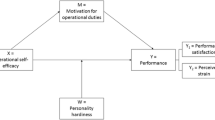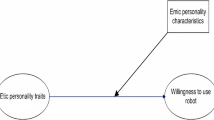Abstract
Personality is considered as one of the internal potential influencing factors of performance and an effective index to predict job performance. Past literature reveals the relationship between personality and task performance, and there is evidence that personality can effectively predict teleoperation task performance. In this study, we aim to explore the impact of personality on teleoperation performance under different situations, and to provide theoretical reference for operator selection. In this study, 96 male participants with no teleoperation experience were recruited. Their personalities were evaluated by the Big Five Inventory. The experimental task is to remotely operate a virtual machine car to complete the designated task, each task will have different levels of latency and clearance. Completion time, distance, collisions, and workload were used as indicators of teleoperation performance. Hierarchical Linear Model was used to test the relationship between personality and teleoperation performance. The results showed that with more clearance and longer latency, the number of collisions in higher extroversion participants significantly increased, while in higher negative emotionality participants, the scores decreased significantly. With more clearance, the workload of participants with higher extroversion scores decreased significantly. Further analysis found that energy level and depression were the main sub-dimensions leading to the increase in the number of collisions among the subjects with high score of extroversion and negative emotionality. With longer latency, the completion time of the participants with higher degree of anxiety increased significantly. The results showed that personality have different predictive effects on teleoperation task performance in different situations. These results may be helpful to the selection of operators.
Access this chapter
Tax calculation will be finalised at checkout
Purchases are for personal use only
Similar content being viewed by others
References
Bacocco, R., Melchiorri, C.: LQ control design of cooperative teleoperation systems. In: 14th International Conference on Advanced Robotics, pp. 1–6. Germany (2009)
Park, S.H., Woldstad, J.C.: Design of visual displays for teleoperation. In: Karwowski, W. (ed.) International Encyclopedia of Ergonomics and Human Factors. CRC Press, Boca Raton (2000)
Boboc, R.G., Moga, H., Talabă, D.: A review of current applications in teleoperation of mobile robots. Bull. Transilvania Univ. Brasov, Ser. I: Eng. Sci. 5(2), 9–16 (2012)
Marescaux, J., et al.: Transcontinental robot-assisted remote telesurgery: feasibility and potential applications. Ann. Surg. 235, 487–492 (2002)
Spinoglio, G., Marano, A., Priora, F., Melandro, F., Formisano, G.: History of robotic surgery. Robot. Surg., 1–12 (2015)
Murphy, R., et al.: Search and rescue robotics. Springer Handbook of Robotics, pp. 1151–1173. Springer, Heidelberg (2008)
Schmidt, G.R., Landis, G.A., Oleson, S.R.: HERRO missions to Mars and Venus using telerobotic surface exploration from orbit (2011)
Haidegger, T., Benyo, Z.: Surgical robotic support for long duration space missions. Acta Astronaut. 63, 996–1005 (2008)
Lester, D., Thronson, H.: Human space exploration and human spaceflight: latency and the cognitive scale of the universe. Space Policy 27, 89–93 (2011)
MacKenzie, I.S., Ware, C.: Lag as a determinant of human performance in interactive systems. In: Proceedings of the INTERACT’ 1993 and CHI’ 1993 Conference on Human Factors in Computing Systems, pp. 488–493 (1993)
Sheridan, T.B.: Space teleoperation through time latency: review and prognosis. IEEE Trans. Robot. Autom. 9, 592–606 (1993)
Sheridan, T.B., Ferrell, W.R.: Remote manipulative control with transmission latency. IEEE Trans. Hum. Factors Electron. HFE-4, 25–29 (1963)
Haidegger, T., Rudas, I.J.: From concept to market: surgical robot development. Human-Computer Interaction: Concepts, Methodologies, Tools, and Applications. IGI Global (2016)
Scholcover, F., Gillan, D.J.: Temporal sensitivity and latency during teleoperation: using track clearance to understand errors in future projection. Hum. Factors, 187208211011842 (2021)
Dybvik, H., et al.: A low-cost predictive display for teleoperation: investigating effects on human performance and workload. Int. J. Hum. Comput. Stud. 145, 102536 (2021)
Kok, L.: Singapore expertise pioneers quick and scarless surgery. Press release of the Nanyang Technological University (2011)
Pan, D., et al.: Association of individual characteristics with teleoperation performance. Aerospace Med. Hum. Perform. 87(9), 772–780 (2016)
Scholcover, F., Gillan, D.J.: Using temporal sensitivity to predict performance under latency in teleoperation. Hum. Factors 60, 80–91 (2018)
Poropat, A.E.: A meta-analysis of the five-factor model of personality and academic performance. Psychol. Bull. 135(2), 322–338 (2009)
Hough, L.M., Furnham, A.: Use of personality variables in work settings. In: Borman, W.C., Ilgen, D.R., Klimoski, R.J. (Eds.) Handbook of Psychology, vol. 12, pp. 131–170 (2003)
Sommer, M., Herle, M., Häusler, J., Risser, R., Schützhofer, B., Chaloupka, C.: Cognitive and personality determinants of fitness to drive. Transport. Res. F: Traffic Psychol. Behav. 11(5), 362–375 (2008)
Upham-Ellis, L.: Perception and displays for teleoperated robots. Doctoral dissertation. Retrieved from UCF Electronic Thesis and Dissertation Digital Collections Database (2008)
Soto, C.J., John, O.P.: The next big five inventory (BFI-2): developing and assessing a hierarchical model with 15 facets to enhance bandwidth, fidelity, and predictive power. J. Pers. Soc. Psychol. 113(1), 117–143 (2017)
Hart, S.G., Staveland, L.E.: Development of NASA-TLX (task load index): results of empirical and theoretical research. Adv. Psychol. 52, 139–183 (1988)
Davidian, M.: Hierarchical linear models: applications and data analysis methods. Publ. Am. Stat. Assoc. 98(463), 767–768 (2002)
Hofmann, D.: An overview of the logic and rationale of hierarchical linear models. J. Manag. 23(6), 723–744 (1997)
Cohen, J.: Statistical power analysis for the behavioral sciences. J. Am. Stat. Assoc. 2(334) (1988)
Lucas, R.E., Le, K., Dyrenforth, P.S.: Explaining the extraversion/positive affect relation: sociability cannot account for extraverts’ greater happiness. J. Pers. 76, 385–414 (2008)
Watson, D., Clark, L.A.: Extraversion and its positive emotional core. In: Hogan, R., Johnson, J.A., Briggs, S. (eds.) Handbook of Personality Psychology, pp. 767–793. Academic Press, San Diego, CA (1997)
Eaves, L., Eysenck, H.: The nature of extraversion: a genetical analysis. J. Pers. Soc. Psychol. 32(1), 102–112 (1975)
McCrae, R.R., Costa, P.T.: NEO Inventories Professional Manual. Psychological Assessment Resources, Lutz, FL (2010)
Saucier, G., Ostendorf, F.: Hierarchical subcomponents of the big five personality factors: a cross-language replication. J. Pers. Soc. Psychol. 76, 613–627 (1999)
Author information
Authors and Affiliations
Corresponding author
Editor information
Editors and Affiliations
Rights and permissions
Copyright information
© 2022 The Author(s), under exclusive license to Springer Nature Switzerland AG
About this paper
Cite this paper
Qin, K., Zhang, Y., Zhang, J. (2022). A Study on the Influence of Personality on the Performance of Teleoperation Tasks in Different Situations. In: Harris, D., Li, WC. (eds) Engineering Psychology and Cognitive Ergonomics. HCII 2022. Lecture Notes in Computer Science(), vol 13307. Springer, Cham. https://doi.org/10.1007/978-3-031-06086-1_16
Download citation
DOI: https://doi.org/10.1007/978-3-031-06086-1_16
Published:
Publisher Name: Springer, Cham
Print ISBN: 978-3-031-06085-4
Online ISBN: 978-3-031-06086-1
eBook Packages: Computer ScienceComputer Science (R0)




